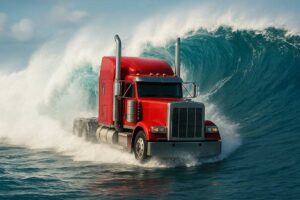It’s no secret that trucking gets a lot of attention for its use of petroleum and production of greenhouse gases. Cleaner-burning fuels, exhaust aftertreatments, and other technologies have been forced upon the industry from the U.S. Environmental Protection Agency (EPA), the California Air Resources Board (CARB), and others.
Through its SmartWay “partnership” program, implemented in 2004, the EPA has pushed transportation-industry decision-makers to adopt fuel-saving technologies that reduce greenhouse gas emissions by reducing fuel consumption. The program is voluntary, but adoption by shippers who are encouraged to include SmartWay scores in the carrier selection process has created a strong incentive to join.
Truck manufacturers have changed their offerings, too. In the 1980s, cabover tractors pulling van trailers presented the aerodynamic advantages of a brick on wheels. With the relaxation of maximum length laws in 1980, designers focused on aerodynamic shapes to save fuel. Freightliner’s FLD was introduced in 1987, followed by the Century Class in 1996. Kenworth’s T600 “Anteater” evolved into the current T680.
Volvo introduced its VN model, soon renamed the VNL, in 1996. On its website (volvotrucks.us), the company claims its “XCEED” full aero package — which includes bumper, air dam, side fairings, cab extenders, trim tab (top fairing), and more — provides up to 16% better fuel economy.
As tractor shapes evolved, most fuel-saving efforts for trailers involved reduced weight. New composite materials were developed for sides and tops. Components manufacturers adopted lighter metal alloys and shaved microns of metal from parts. Low-profile tires became more popular.
At the same time, vendors developed aftermarket products that claimed to reduce fuel consumption. Trailer skirts appeared, along with scoops, fairings, “tails,” and other products. Wheel covers and flow-through mudflaps appeared. Carriers listened to the sales pitches; then performed their own experiments to determine if the return on investment was worthwhile for their fleets.
Today, manufacturers of both tractors and trailers are offering their own versions of some of these products or teaming up with aftermarket retailers to install their products at the factory or at dealers. FlowBelow Aero Director of Sales Operations Katie Breitschopf has seen her company’s offering grow in the tractor market while beginning to gain traction on the trailer side.
“On the tractor side of the house, we’ve got a really big following and a lot of tractors with cover kits and fairing kits going out the door,” she said. “All the OEMs, offer us as a first fit from the factory.”
FlowBelow’s AeroKit includes wheel covers and wind fairings that fill space between drive axles and behind.
On the Volvo website, FlowBelow fairings and wheel covers are shown in photos of VNL 760 and 860 models.
Product Marketing Manager Chris Stadler explained, “We just started putting pictures together with that. We wanted to emphasize that to our customers that the option is available within the order.”
According to Stadler, Volvo also offers aftermarket products such as flow-through mudflaps and “vortex generators” that can be installed at the dealer.
Like vendors of other aero products, Breitschopf points to independent product testing at a credible source, MVT Solutions (m-v-t-s.com). Formed in 2016 when Mesilla Valley Transportation partnered with InnoMetric MPG, MVT Solutions (MVTS) offers testing and consultation services to the industry.
MVTS testing showed that tractor wheel covers alone saved a little less than 1% of fuel (0.93%), while the full AeroKit resulted in a 2.13% fuel savings. Adding wheel covers to the trailer saved another 0.81%.
“Our tractor customers love them, so now they’re starting to put them on their trailers,” explained Breitschopf. “We
offer them straight from the factory, through Wabash, through Utility, and through Great Dane.”
Full testing reports for FlowBelow and other products, including offerings from Utility and Wabash, are available on the MVTS “Certified Products” page.
One of the earliest aero technologies to be adopted on trailers was the side skirt, closely followed by the trailer tail. Wabash National Product Development Engineering Manager Aaron Smith shared that those items have the most immediate impact on fuel savings.
“Both side aerodynamic skirts and rear aerodynamic systems are very competitive in terms of achievable fuel savings performance,” he explained.
MVTS has tested Wabash’s Ventix DRS skirt system and AeroFin tail systems, finding that the combination resulted in fuel savings of 9.03%, reducing fuel consumption by 10.39 gallons per 1,000 miles of driving.
Smith said Wabash aero products can produce fuel savings of up to 4.2%.
“Wabash National offers our own side skirts, as well as other suppliers’ solutions, including a rear fairing,” he said. “We can assemble other manufacturers’ solutions upon a customer’s request.”
Utility Trailer also offers a choice, according to Utility Trailer Sales of Utah Vice President of Sales Spencer Deputy.
“Many of our customers are purchasing aerodynamic equipment directly from the manufacturer, or we install it here,” Deputy said. “One of the items we are frequently asked for is the UAT or Utility Aerodynamic Tail.”
MVTS has tested the UAT, finding a fuel savings of 0.81%. When coupled with Utility’s side skirt option, the savings increases to 5.56%.
All of the available technology doesn’t work for everyone. Trailer tails, for example, won’t work for flatbed or tank trailers, while drop-frame (moving van) trailers leave little room for side skirts. Nearly everyone, however, can benefit from some form of aero technology on tractor, trailer, or both.
Stadler advised buyers to consider the application.
“We look at the customer’s operation and help them with the specs of the vehicle,” he said. “There’s more demand for fuel economy, especially now with fuel prices starting to increase. They understand that the aerodynamics will help in fuel efficiency, so they’re adding those components to the vehicle more and more.”
The wealth of real-world testing information available through MVTS or other testing facilities makes it easier than ever to calculate return on investment. The revenue gained from shippers who demand good SmartWay scores is another plus, although difficult to calculate.
Even as technology brings changes such as electric trucks, possibly autonomous, aero technology will still be around to help keep cost-per-mile as low as possible.
Cliff Abbott is an experienced commercial vehicle driver and owner-operator who still holds a CDL in his home state of Alabama. In nearly 40 years in trucking, he’s been an instructor and trainer and has managed safety and recruiting operations for several carriers. Having never lost his love of the road, Cliff has written a book and hundreds of songs and has been writing for The Trucker for more than a decade.















